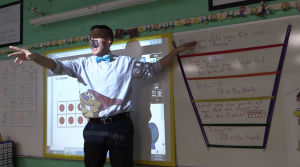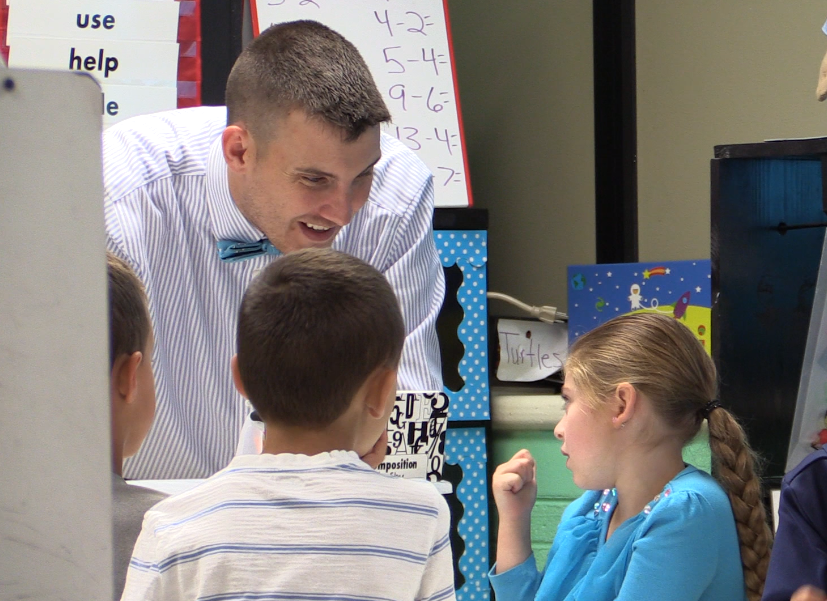Authentic engagement in a primary classroom is not available upon demand. It involves precise planning, innovative thinking, and the ability to make connections to the real world at a student friendly level. Basically, the curriculum must be brought to life. Finding ways to do so is such a beautiful challenge. The first ten minutes of any lesson are the ones that students remember the most. It is the hook of the lesson. What happens after these first ten minutes is absolutely crucial. This year, I really wanted to focus on engagement strategies to help keep my students “in the game” all throughout the lesson. The HOT (Higher Order Thinking) question trapezoid and standing tables used in this lesson have been real game changers in my goal of increasing student engagement and lesson pacing.
In my classroom, we start out our day by having students intentionally point to and chant the target. On this same board, I like to list how I am going to assess my students. By doing so, they will understand how they are going to show me what they have learned, as they are learning it. I try to keep learning styles in mind here and give students the opportunity to express their knowledge in different ways throughout the year.
 The HOT question trapezoid helps keep the students on a pathway to the target goal for the day. It really helps with applying previously learned skills to reach our target destination. From a teacher’s standpoint, having something like this to glance at throughout the lesson helps me ensure that I am not skipping a key term or approach. It allows me to use formative assessment tools such as Plickers throughout the lesson (assessment during instruction) to make sure that I am not running off and leaving students behind. Real time data collected from these five pre-planned questions on the trapezoid allows for immediate feedback and correction throughout the lesson (informing me to slow down or move on). Dissecting the lesson with higher order thinking questions assessed through Plickers has been a great way for me to let my data literally drive the direction of my instruction within the lesson. Results of these questions assessed during instruction allow for instant feedback to groups of students, also. We often times address this with co-teachers and parallel teaching strategies.
The HOT question trapezoid helps keep the students on a pathway to the target goal for the day. It really helps with applying previously learned skills to reach our target destination. From a teacher’s standpoint, having something like this to glance at throughout the lesson helps me ensure that I am not skipping a key term or approach. It allows me to use formative assessment tools such as Plickers throughout the lesson (assessment during instruction) to make sure that I am not running off and leaving students behind. Real time data collected from these five pre-planned questions on the trapezoid allows for immediate feedback and correction throughout the lesson (informing me to slow down or move on). Dissecting the lesson with higher order thinking questions assessed through Plickers has been a great way for me to let my data literally drive the direction of my instruction within the lesson. Results of these questions assessed during instruction allow for instant feedback to groups of students, also. We often times address this with co-teachers and parallel teaching strategies.
The tables in the room have been raised to standing tables with the table socks. This is something that I have developed, and it is very cost efficient while being quickly interchangeable. Being able to change back and forth so quickly in a primary classroom has proven to be valuable. Transitioning from a differentiated morning message to strategically based “standing” arrangements at tables can happen so much faster with these standing tables. Station rotations, along with other transitions, are much more time efficient as well, as chairs have been momentarily taken out of the equation. The tops of the tables are dry erase and we keep the markers and pencils in a table caddie at the center of each table top. As engagement has increased for every student, we are also saving educational minutes along the way with these tweaks.
Taking a chance on the standing tables has really paid off for me. I give all the credit to my friend, Mr. Thacker, for the inspiration on the concept. As an educator, he has reminded me that sometimes we must get out of our comfort zone in order for the students to get into their own. So true.
For more information on classroom redesign check out the Innovative Learning Spaces Holler.

